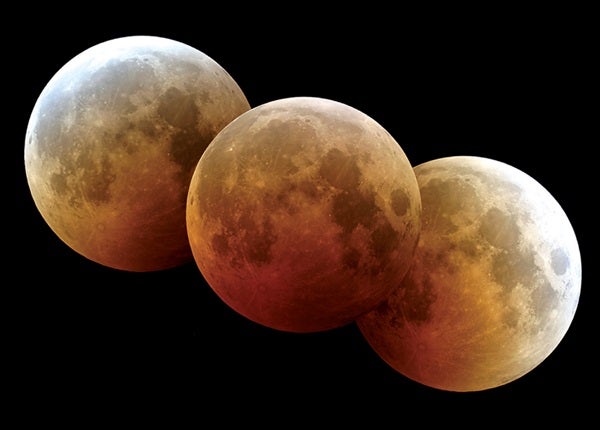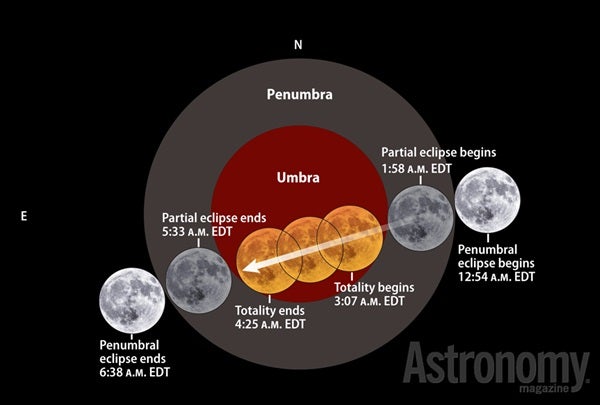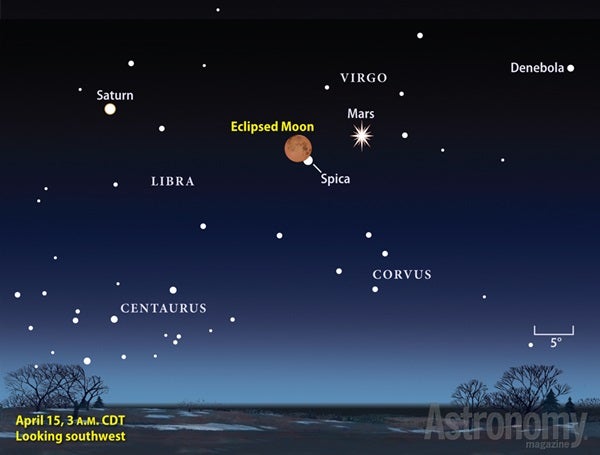If you’re dreading the deadline for filing your taxes in the U.S., the sky will provide a distraction in the early morning hours of April 15. That’s when we’ll experience the first total lunar eclipse in 28 months.
Observers throughout North and South America will have the prime views of this eclipse. Those in the western Pacific will miss the first half of the eclipse because it occurs before the Moon rises. Likewise, most of Europe and Africa will experience moonset just as the eclipse begins.
Bad weather or not in a good location for tonight’s total lunar eclipse? Production Editor Karri Ferron provides some virtual viewing alternatives.
A lunar eclipse occurs when the Sun, Earth, and the Moon line up. During such times, the Moon passes through Earth’s shadow, and where it passes determines the type of eclipse we’ll see.
Our planet’s shadow has two parts: a darker inner section called the umbra and a lighter outer region called the penumbra. When the Moon passes through only the penumbra, we experience a penumbral eclipse. When only some of it passes through the umbra, we see a partial eclipse. Sometimes, however, all of the Moon passes through the umbra, creating a total lunar eclipse. That’s what’s happening on the 15th.
The event starts at 12:54 a.m. EDT as the Moon enters the penumbra of Earth’s shadow. Most observers won’t even notice any change in our satellite’s appearance for at least a half-hour after this time.
Things begin to heat up at 1:58 a.m. EDT. That’s when the Moon first hits Earth’s umbral shadow and the partial phase begins. For more than an hour you’ll see the dark part grow until totality begins at 3:07 a.m. EDT.
Totality lasts 78 minutes, until 4:25 a.m. EDT. The partial phase is over at 5:33 a.m. EDT, and the penumbral phase — and this eclipse — ends at 6:38 a.m. EDT.
The Moon’s appearance during totality can vary greatly from one eclipse to the next. The path the Moon takes through Earth’s umbra — and how centered it is — has an effect. But so does our atmosphere. It can darken the shadow because it contains water droplets and solid particles like dust and ash, which reduce the air’s clarity. Lots of clouds along the edge of our planet also can cut down the light.
But in addition to appearing dark, the Moon takes on a particular color during totality. This occurs because our air bends some of the Sun’s rays into the shadow. It also scatters the shorter (bluer) wavelengths out of that light, reddening it and darkening the Moon’s face.
On April 15, the Moon’s northern edge passes a tiny bit south of the shadow’s center. In contrast, its southern edge lies a lot farther from that point. As a result, the Moon’s northern half will look much darker than its southern half because it lies deeper in the umbra.
The totally eclipsed Moon on April 14/15 lies in the southern part of the constellation Virgo the Maiden, just 2° from that star pattern’s brightest star, Spica (Alpha [α] Virginis), and 9° from Mars. The ringed planet Saturn also floats nearby, some 27° to the Moon’s east-southeast.
During totality, the constellations of the Northern Hemisphere’s spring surround the Moon. Magnitude 1.0 Spica in the constellation Virgo the Maiden is the nearest bright star. At mid-totality, it lies just 1.5° west-southwest of the eclipsed Moon. Spica’s vivid blue color will contrast nicely with the crimson Moon — especially through binoculars. Regarding other bright stars, Arcturus in the constellation Boötes stands 32° to the Moon’s north-northeast, and Antares in Scorpius lies 45° to the east-southeast.
Mars will dazzle 9.4° northwest of the Moon. On eclipse morning, the Red Planet lies relatively close to Earth and shines at magnitude –1.4, as brightly as it will until 2016. It’s also as large as it will be until then, so if you have a telescope set up for the eclipse, you’ll have plenty of time to steal a glance at Mars, even during totality.
Astronomy Senior Editor and veteran eclipse watcher Richard Talcott notes how safe this event is to watch. “A lunar eclipse poses no danger whatsoever to your eyes,” he says. “All you’re looking at is the Moon passing through a big shadow. Not only do you not need any filters, but you also can feel free to magnify the sight by using binoculars or a telescope.”
So, invite your family and friends, host an eclipse viewing party, and revel in some cool, easy-to-understand science. Lots of astronomy clubs and science centers will be doing the same. Observing this sky event takes little effort. You can watch the whole thing or just part of it. You can use a telescope, binoculars, or just your eyes. You can view it from the darkest site on Earth or from the heart of a city. However you watch it, have fun.
Expand your knowledge with these tools from Astronomy magazine
- Video: How to observe a lunar eclipse, with Michael Bakich, senior editor
- StarDome: Locate the Moon in your night sky with our interactive star chart.
- The Sky this Week: Get your lunar observing info from a daily digest of celestial events coming soon to a sky near you.
- Sign up for our free weekly e-mail newsletter.












